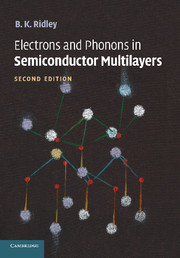Book contents
- Frontmatter
- Contents
- Preface
- Introduction
- 1 Simple Models of the Electron–Phonon Interaction
- 2 Quantum Confinement of Carriers
- 3 Quasi-Continuum Theory of Lattice Vibrations
- 4 Bulk Vibrational Modes in an Isotropic Continuum
- 5 Optical Modes in a Quantum Well
- 6 Superlattice Modes
- 7 Optical Modes in Various Structures
- 8 Electron–Optical Phonon Interaction in a Quantum Well
- 9 Other Scattering Mechanisms
- 10 Quantum Screening
- 11 The Electron Distribution Function
- 12 Spin Relaxation
- 13 Electrons and Phonons in the Wurtzite Lattice
- 14 Nitride Heterostructures
- 15 Terahertz Sources
- Appendix 1 The Polar-Optical Momentum-Relaxation Time in a 2D Degenerate Gas
- Appendix 2 Electron/Polar Optical Phonon Scattering Rates in a Spherical Cosine Band
- References
- Index
15 - Terahertz Sources
Published online by Cambridge University Press: 05 September 2009
- Frontmatter
- Contents
- Preface
- Introduction
- 1 Simple Models of the Electron–Phonon Interaction
- 2 Quantum Confinement of Carriers
- 3 Quasi-Continuum Theory of Lattice Vibrations
- 4 Bulk Vibrational Modes in an Isotropic Continuum
- 5 Optical Modes in a Quantum Well
- 6 Superlattice Modes
- 7 Optical Modes in Various Structures
- 8 Electron–Optical Phonon Interaction in a Quantum Well
- 9 Other Scattering Mechanisms
- 10 Quantum Screening
- 11 The Electron Distribution Function
- 12 Spin Relaxation
- 13 Electrons and Phonons in the Wurtzite Lattice
- 14 Nitride Heterostructures
- 15 Terahertz Sources
- Appendix 1 The Polar-Optical Momentum-Relaxation Time in a 2D Degenerate Gas
- Appendix 2 Electron/Polar Optical Phonon Scattering Rates in a Spherical Cosine Band
- References
- Index
Summary
What radiance of glory, What bliss beyond compare.
Jerusalem the Golden, James Mason NealeIntroduction
In recent years there has been growing interest in sources of radiation whose frequencies occupied the region of the electromagnetic spectrum between, roughly, 300GHz and 30THz. The numerous applications include their use in medicine, molecular spectroscopy, communication, and security. The frequency range is covered by free-electron lasers, but there is an obvious need for more portable and adaptable sources, and this need has focussed attention on the properties of semiconductors and semiconductor multilayers. Existing semiconductor microwave generators such as the Gunn diode run out of power above 100GHz and IMPATTs above 300GHz. A new generation of devices that can extend the wavelength range beyond the familiar millimetre wave regime and into the sub-millimetre regime is required, and there has been substantial progress in recent years, much of it associated with the exploitation of the femtosecond Ti-sapphire laser and various non-linear optical processes. Semiconductors have also been used as THz detectors, notably, Ge and Si bolometers operating at liquid helium temperatures. The photon energy at 1THz is 4meV, and photon energies of room temperature radiation are around 25meV, so the problem of detection of THz radiation is that it is always against a competing, pervading background. Mention in Section 14.6 has already been made of cascade lasers operating in the near infrared.
- Type
- Chapter
- Information
- Electrons and Phonons in Semiconductor Multilayers , pp. 369 - 392Publisher: Cambridge University PressPrint publication year: 2009

